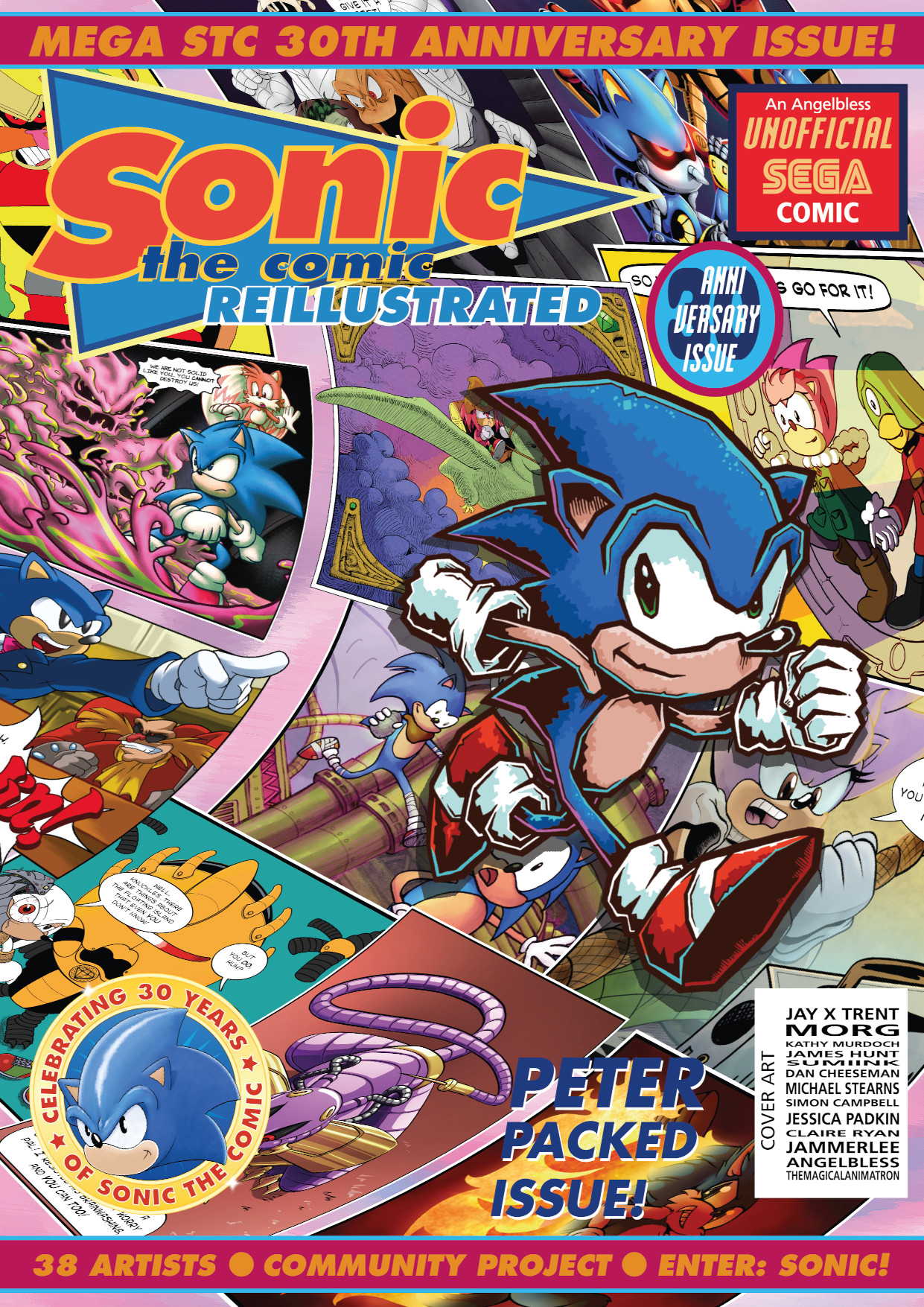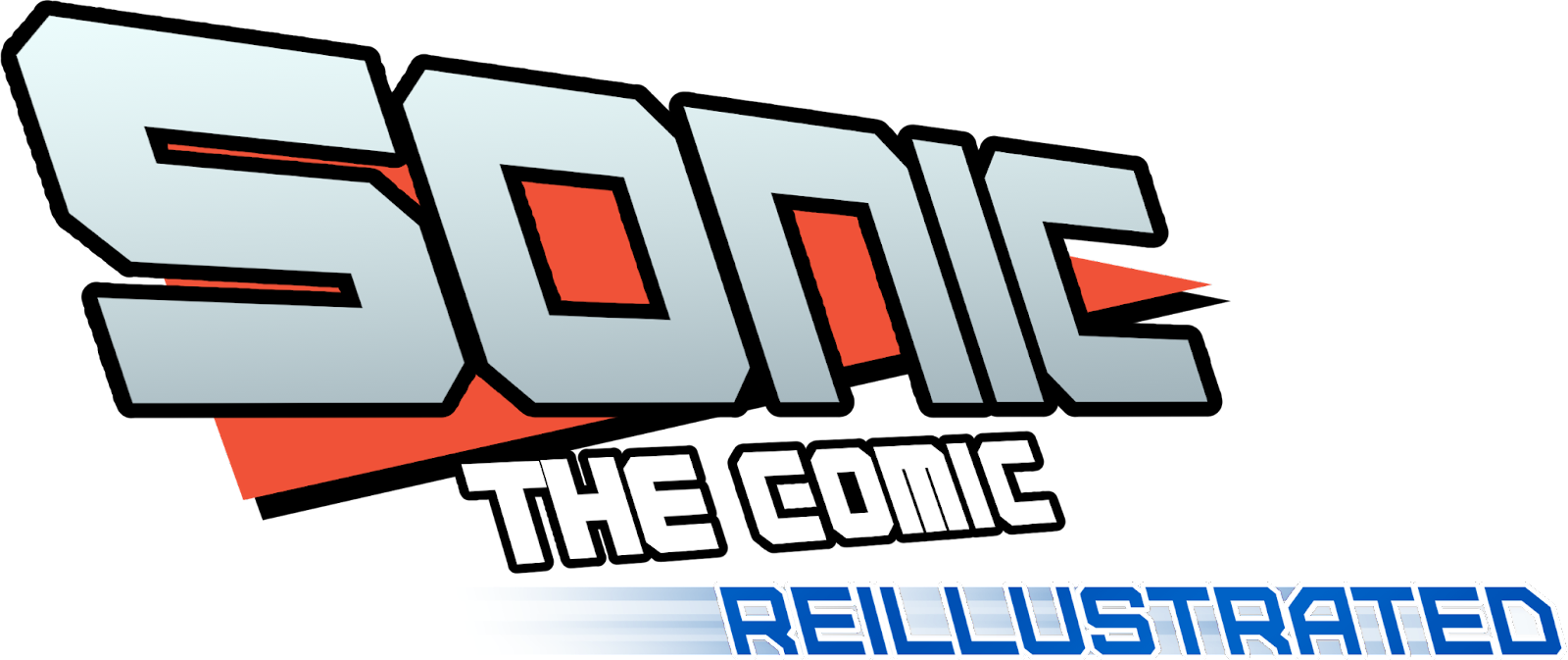By Angelbless
Hi, boomers!
Here's where you can find Issue 3 of Sonic the Comic: Reillustrated, a fan-led project to recreate our favourite Sonic the Comic strips with a different artist for each panel. This issue celebrates 30 years of Sonic the Comic! See how you can get involved with future issues on our about page!
Sonic the Comic: Reillustrated - Issue 3

Read it on Twitter | Tumblr Download it as a CBZ
This issue recreates Enter: Sonic from the very first issue of STC. It also features an exclusive interview with original STC staff Nigel Kitching, Richard Elson, and Ferran Rodriguez, plus a Graphic Zone which further increases the artist count for this issue! You can read the interview below, or find it in the CBZ.
Enter: Sonic introduces Sonic and Doctor Robotnik, along with animal friend Porker Lewis who would later become a member of the freedom fighters. It was particularly notable for starting STC's tradition of drawing inspiration from the games.
Credits Zone
Thank you so much to all the humes who contributed and helped with getting this issue completed!
- Project Lead: AngelBless
- Project Coordinator: Kathy Murdoch
- Graphic Design: TheMagicalAnimatron
- Lettering: Claire Ryan
Artists:
- Page 1, Panel 1: TheMagicalAnimatron
- Page 1, Panel 2: Simon Campbell
- Page 1, Panel 3: Nigel Kitching
- Page 2, Panel 1: Jake Parappa Hainey
- Page 2, Panel 2: Nikki Stu
- Page 2, Panel 3: Morg
- Page 2, Panel 4: oliviacat11
- Page 2, Panel 5: Ben Allen
- Page 3, Panel 1: TheRealBaconGuy
- Page 3, Panel 2: Jay X Trent
- Page 3, Panel 3: David North
- Page 3, Panel 4: Zak Simmonds-Hurn
- Page 3, Panel 5: Junipart
- Page 3, Panel 6: Kathy Murdoch
- Page 4, Panel 1: Chris Z
- Page 4, Panel 2: ThrowableAxe
- Page 4, Panel 3: Calyfern
- Page 4, Panel 4: Abby Bulmer
- Page 4, Panel 5: Pete Murphy
- Page 4, Panel 6: Michael Stearns
- Page 5, Panel 1: Tom Carter
- Page 5, Panel 2: Heather Ballard
- Page 5, Panel 3: Claire Ryan
- Page 5, Panel 4: Angelbless
- Page 5, Panel 5: Zoe Davis
- Page 5, Panel 6: Mister Neowl
- Page 6, Panel 1: SumiInk
- Page 6, Panel 2: Jessica Padkin
- Page 6, Panel 3: anomalousWanderer
- Page 6, Panel 4: Dan Cheeseman Art
- Page 6, Panel 5: Danji's Designs
- Page 7, Panel 1: lovethewolfgirl
- Page 7, Panel 2: James Hunt
- Page 7, Panel 3: JaredTheBC
- Page 7, Panel 4: keh-arts
- Page 7, Panel 5: Stari
- Page 7, Panel 6: Jamie "Jammerlee" A. Lee
- Page 7, Panel 7: Starkat
Graphic Zone:
Interview Zone
We collected questions from our contributors to put to three original STC humes, and put them to each of them via email. Responses were received between 4th and 16th March 2023 (we know one question's already out of date!)
Nigel Kitching: Before I start I just want to say that this all feels like a long time ago now so I can’t promise all my recollections will be 100% accurate. But I’ll give it a go.
Q: There were very few reference points for the Sonic franchise at the time the comic started; what challenges did this cause you and how did you resolve them?
Nigel Kitching: Some of the things you might think of as being a challenge were actually positives. I had quite a bit of freedom to come up with ideas that were just inspired by what I saw in the game. The organic battery idea, for example, was just my attempt to make sense of why robots would have little furry animals stuck inside them.
My take on Super Sonic was also inspired by just playing the game.
My editor, Richard Burton, suggested I look at a book called ‘Stay Sonic’ (I think). So I got some stuff from that. I’m also pretty sure the freedom fighter idea was suggested to me by Richard.
But I stayed away from the TV cartoons – I wanted to go my own way. Even though I think one of these series may also have taken the freedom fighter angle.
So I was lucky and it really felt like I had options to take Sonic in directions that interested me. I tried to tap into what made me excited about comics when I was a kid.
Richard Elson: Sega supplied us with a bible of images, mostly taken from the instruction booklets that came with the early games. A company called Copyright Promotions were tasked with overseeing the Sega characters and making sure that all of the artists were on model. They were quite restrictive on what we were allowed to do and things became quite difficult with multiple changes being made to the art on some issues. A meeting was arranged between Sega, a bunch of us that worked on STC and Copyright Promotions to see if we could overcome the problems that we were having in working to their strict rules. Luckily, Sega came down on our side and Copyright Promotions gave us far more leeway to be creative with our representations of the Sega characters from that point onwards.
Ferran Rodriguez: I was given very few references. A couple of Sonic poses pages. One of Tails and Robotnik and another with the Badniks, also a poster with Sonic and Tails on the plane. I was working through an agent and it was my first comic work ever so, I didn't know I could ask for more, if there were. I had to stop the game frame by frame to draw Robotnik's spaceship on "The Death Egg", draw it in pieces and join all together.
Q: Were there any strips in STC you wish you'd had a chance to work on, or any of your own that you would redo now, given the chance?
Nigel Kitching: Nothing really springs to mind. I would have liked to have worked on more Streets of Rage stuff – it was fun and (hopefully) showed I could write more gritty and realistic stuff. Had great fun working with Peter Richardson on this.
I’m sure there are a few things that would benefit from a rewrite but the one thing I would really like to do is redraw some of the Decap Attack strips. Some of these were drawn far too quickly and I think it shows. I was probably trying to do too much work at the time so couldn’t really give the drawing the care it needed.
Richard Elson: I would like to have drawn a few episodes of Decap Attack.
As with everything that I have ever done, there are multiple strips that I drew for STC that I would like to redraw.
Ferran Rodriguez: If I had the chance I would like to redraw almost everything. Sonic was my first job ever so it can easily be improved. The "Death Egg" was drawn following the game shots, I was asked for it. Due to that the editor wanted me to stop, luckily they understood what happened.
"Doctor Sun" was a terrible mistake. My Agent asked me to draw a new story, right after finishing another in a very short period of time ... I did not sleep for a couple of days ... this was the last story I worked on.
Q: How much feedback from the reader base did editorial pass on to you, and how much did you take that into account?
Nigel Kitching: I was in touch with some of the fans online on a Google Groups kind of thing – don’t quite remember what it was. So I’d get some feedback there. I did occasionally see letters too. I do think it’s important to be aware of the audience but maybe not a good idea to be overly influenced by comments. I was writing stuff that pleased me and could only hope the readers felt the same. It may well be I got it wrong sometimes, but I’m prepared to take responsibility for that.
Richard Elson: I received quite a lot of mail from the office. I wish that I had had time to answer it all personally, but the comic would rarely have got to print on time if I did. The comments were overwhelmingly positive, from what I remember. There was very little in the way of criticism (constructive or otherwise) so I don’t think anything in the comic got changed as a direct result of reader feedback, as far as I recall. It may have been different for the editorial staff.
Q: Did you plot the longer arcs out in full before scripting each one, and how did you leave hooks for later scripts to use without them looking like plot holes?
Nigel Kitching: If I was writing a six-part Knuckles story (for example) I’d have the idea and the situation but probably not the end. The ending would occur to me as the story unfolded while I wrote it. But by the end of part four I’d have it figured out. I don’t like planning out too much in advance and enjoy, what I feel, is allowing creativity to happen during the writing process. Of course sometimes I’d be asked to write up a story synopsis and, in this case, I’d have to come up with an end of sorts. But it would often change in the writing. I don’t recall deliberately leaving hooks for future scripts. It was more that the reading of the published story would give me ideas how to develop new directions. But my memory may be faulty on this one. And I’m pretty sure my stuff is full of plot holes if we made the effort to look for them. As for the Sonic main strip we had a mix of longer stories and single-issue ones. I do remember planning out story arcs but not any details I’m afraid. Of course, on Sonic, I worked closely with Richard Elson and we’d come up with plot ideas together. Quite a few of the ideas are his.
Q: Having worked in both traditional and digital media over the course of STC's run, is there one medium that you prefer over the other or are there elements that you enjoy from both?
Richard Elson: I think that images produced using traditional media look better, in general. Digital is cleaner, and can be quicker (though the infinite choices available can cause problems for procrastinators, like me), but it’s far rarer that I feel happy with a finished digital image compared to a traditional one. Despite working 100% digital for about 15 years, I still regularly threaten to abandon it and return to traditional materials.
Q: It's been mentioned that Nigel Kitching would send you [Richard Elson] tapes of himself playing Sonic so that you could see the Zones you were supposed to be drawing. Was he any good at it?
Richard Elson: Probably a lot better than me. I was far more of a Mario guy. 😊
Q: The plots from the Megadrive games were very straightforward, leaving a lot of room for your own creativity. As the games continued and the plots became more complicated and more specific, how would your approach to adaptation have changed?
Nigel Kitching: I think I would have found the new games a pain to adapt to be honest. And by this time Rich [Richard Elson], Nigel [Nigel Dobbyn] and I really had our own world and I was happy to work with that.
Q: How did your writing/art style change as a result of working on STC? Has it had a lasting impact?
Nigel Kitching: I think I developed a lot as a writer during my time on STC. I’m sure it had a lasting impact on me but I find this question quite hard to answer to be honest.
Richard Elson: My art style was changing before I started on STC, thanks to work on comics like the Teenage Mutant Hero Turtles. It continued to change throughout my time on STC and still does to this day. That’s my opinion, anyway; I’m never sure how things look to others, so it may be that what I see as a radical change looks indistinguishable from my previous work to others. I certainly think that my storytelling and sense of dynamics improved as I worked on STC.
Ferran Rodriguez: I didn’t have an art style before Sonic, so you can imagine how it influenced me.
Q: Do you have a favourite contribution or memory of working on Sonic the Comic?
Nigel Kitching: Not really. But I loved working with Richard Elson, Nigel Dobbyn and Richard Piers Rayner. These three were all good friends – to be fair Rich became my friend during our time on STC. I also got to write for Mick McMahon who is my favourite British comic artist ever. As for the strips, I liked working on all of them. I was always fond of Porker Lewis though and he was fun to write. He was maybe the character in the Sonic strips who developed the most.
Richard Elson: I have many fond memories of working on STC. To this day it is probably my favourite work experience. Being actively encouraged to contribute story ideas, by Nigel, was a particularly satisfying aspect of the work that kept me very engaged. I think the final 10 part Chaos story that Nigel and I worked on and the final story that Lew and I did immediately before that were some of the best things I have drawn. It’s nice to think that the original stories in the comic got to end so strongly. I liked working on the Drakon Empire stuff a lot too. There aren’t many earlier strips that I particularly like to look at these days, but the first Knuckles solo story that I did was OK, I think.
Most of my good memories involve the people I met and the friendships that I gained working on the comic. My co-contributors on STC are still amongst my favourite people on the planet.
Ferran Rodriguez: The cover of the Issue 3 was picked when I was in the hospital the day my daughter was born: 18th of May 1993.
Q: Do you have a favourite artist/writer you'd like to work with or have worked with more?
Nigel Kitching: Most of my favourite artists are dead. As I say I got to work with my favourite UK artist – Mick McMahon. That was a real treat. I’d like to write a Decap Attack script for Frank Miller. That would be really interesting. But also kind of unrealistic.
Richard Elson: I’ve been extremely lucky to have worked with a lot of very talented writers over the years. Every time I work with Dan Abnett is a treat for me. He always writes in a way that makes my job fun. I’d like to work with Dan Slott again. Nigel and Lew were both great collaborators and any chance to work with them is great. I would like to do a Superman, New Gods, or Doctor Strange, story written by Grant Morrison, I always enjoy the insanity of his work. To be totally honest, the thing that I’d most like to do is to draw some of my own stories after so many years drawing those of other people. I have built up a large catalogue of characters and story ideas while working on other people’s scripts and have a strong desire to get those out in future.
Ferran Rodriguez: At the time I didn’t have enough experience to know if the writers were good or not, anyhow Nigel was great.
Q: If the Sega Superstars strips had continued, is there a Sega property you would have liked to draw/adapt?
Nigel Kitching: I’m afraid I know nothing of Sega Superstars. I’m a bit out of touch with Sega games, well games in general really.
Richard Elson: I think I could have had some fun working on Altered Beast or Panzer Dragoon. Regarding non Sega properties from that era—I really enjoyed the Konami games Castlevania and Super Probotector and would have liked to get the chance to adapt those. From Capcom, SFII and Resident Evil were very popular in my house. Oh yeah, speaking of Resi, how about The House of the Dead? I’m not sure that would fit well into STC. 😊
Ferran Rodriguez: Any one of them would have been really welcomed.
Q: If you were invited to participate in IDW now, would you be interested?
Nigel Kitching: That might be fun.
Richard Elson: I’m not sure that the type of work that we were doing on STC in the 90s would sit well with the IDW audience. Maybe they’d want a more contemporary look. I wouldn’t mind doing a cover.
Ferran Rodriguez: Having the chance of drawing Sonic stories properly would be a dream. The character opened the door to drawing comics for me. After 30 years, I have learned a little, well that's what people say, going back to Sonic, apart from being funny, would be a way of returning to the character something he gave me.

